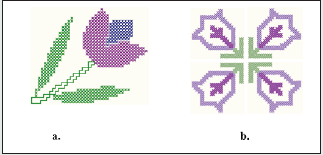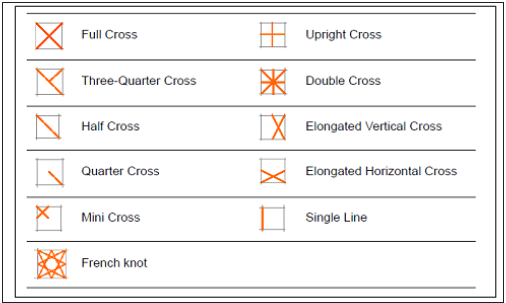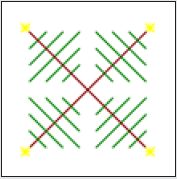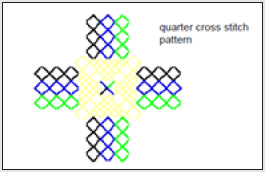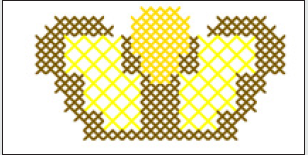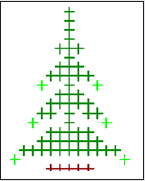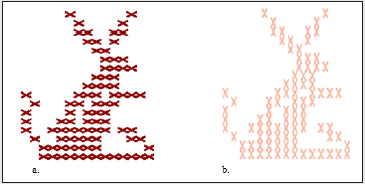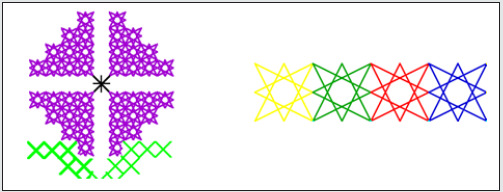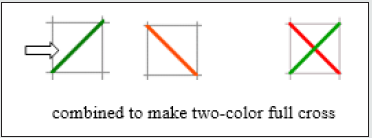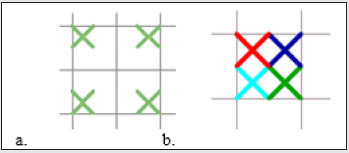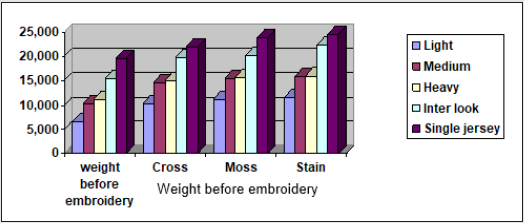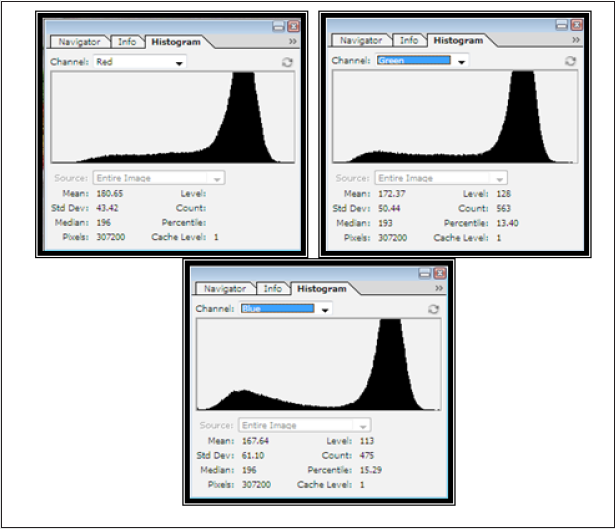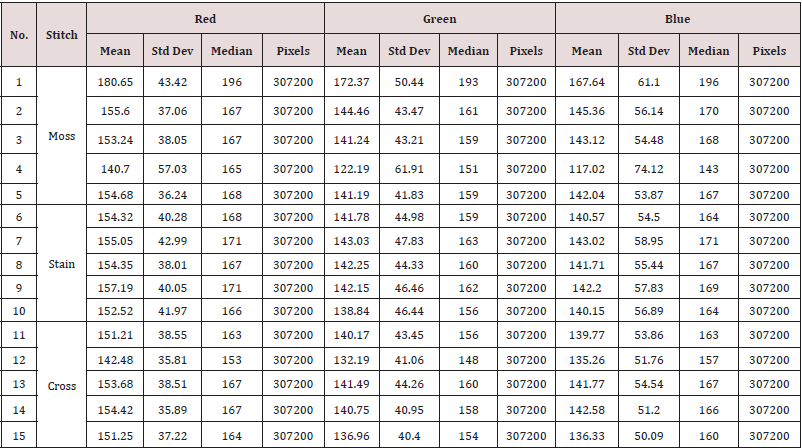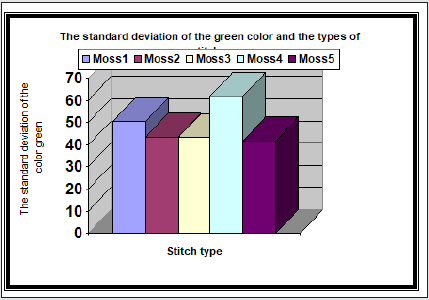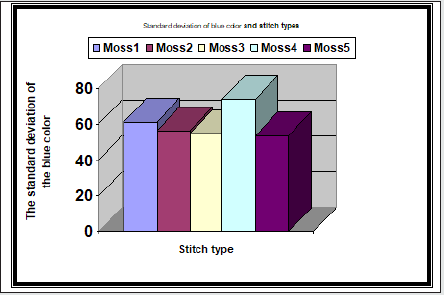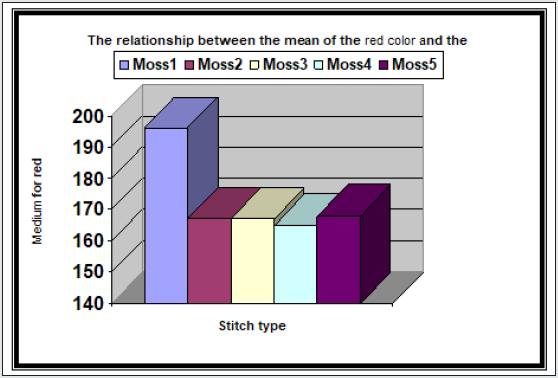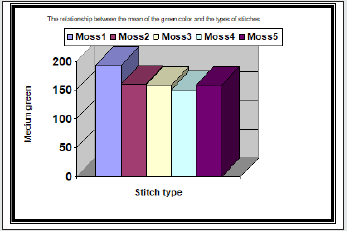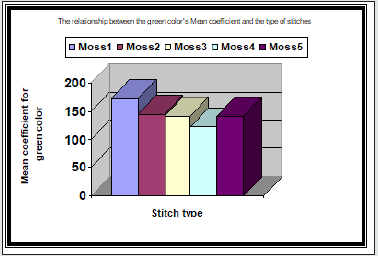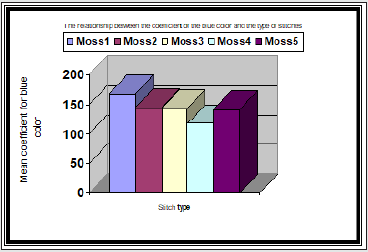
Lupine Publishers Group
Lupine Publishers
Menu
ISSN: 2637-4595
Review Article(ISSN: 2637-4595) 
Color Subtraction Geometric on Types Structures of Stitches in Embroidery of Computer Machine Volume 4 - Issue 4
El Sayed Ahmed El Nashar1* and Albu Adina Victoria2
- 1Professor, Department of Textiles & Apparel, Kaferelsheikh University, Egypt
- 2Faculty of Energetic Engineering and Industrial Management, Department of Textiles, Leatherworks and Industrial Management, University of Oradea, Romania
Received:January 11, 2022 Published: January 26, 2022
*Corresponding author: El Sayed Ahmed El Nashar, Professor, Department of Textiles & Apparel, Kaferelsheikh University, Egypt
DOI: 10.32474/LTTFD.2022.04.000192
Abstract
Subtractive Mixture of Two Reflectance Curves Suppose we have the reflectance curves for two colors we wish to mix subtractive. After researching the web for insight into this, I found that multiplying the reflectance curves together is a step in the right direction, Size does matter when doing some embroidery work. Many users of home embroidery and sewing machines have become very creative, as sewers are known to be, by using their home embroidery machine. But will mimic a special type of subtractive mix that results from passing white light through two colored filters, assuming the filters have transmittance curves matching the reflectance curves of two colored objects. Although in embroidery machine where designs are enhanced with different stitch types, angles, and effects, but in the present research has showed that by using Cross stitching embroidery as a popular technique for filling large areas with minimum stitch numbers with embroidery machine could generally enhance the outlines and borders embroidery stitches To do large field embroidery by using multiple-hooping per garment have been taking place. For One of the most widely available catalogs of reflectance curves comes from the Munsell Color System publications.15 This system describes object colors by hue, chroma (similar to saturation), and value (similar to brightness). Cross stitch, therefore, can add dimension to the designs with shades and colors as well as aesthetic aspects more than the ordinary stitches.
Keywords: Colour Subtraction; Geometric; Stitches; Embroidery; Computer Machine
Introduction
Example of embroider a design that is outside the limits of the home machine’s hoop size, like large sweatshirt embroidery or sewing a logo on a beach towel or children’s garments, blankets, and other large surfaces, as well as the folk designs also jackets as well as with appliqué combination, that need embellishing, are all very interesting [1]. Cross stitching is a popular technique for filling large areas with low stitch counts. It can also be used for outlines and borders. It is suitable for home ware, tablecloths, children’s clothes, and folk designs. Cross stitch is also sometimes combined with appliqué. Unlike machine embroidery where designs are enhanced with different stitch types, angles, and effects, in cross stitch you can only add dimension to the design with shades of colors. For this reason, most cross stitch designs use many more colors than machine embroidery [2-5] (Figure 1).
Types of Cross Stitch
Cross stitches are created on a matrix of squares or ‘pixels. Any part of the square can be stitched, from the edges to the diagonals. The full range of cross stitches is listed below [2,5] (Table 1).
Cross stitch fills: When using cross stitch as a fill you can select
from any of the cross stitch fill types [2,5].
Full cross stitch: Full cross stitches are made up of two equallength
stitches that cross at the center to form an X. The overall
effect depends on which stitch within the X lies beneath or on top.
You can also mix and match for special effects [2,3,5] (Figure 2).
A three-quarter stitch is most often created by stitching a quarter
stitch followed by a half stitch. A different effect is achieved by
stitching the half stitch first and anchoring it with the quarter
stitch. The long arm of the three-quarter stitch can go either / or \
directions. Frequently a quarter stitch and a three-quarter stitch of
different colors share a single square. Mix and match their positions
to give different effects [2,5] (Figure 3).
Half cross stitch: A half stitch is simply a diagonal stitch that looks like / or like \. Half stitches are usually used for shadows and background shading. The stitch can start from any corner. Sometimes two half stitches of different colors are used to make one full cross stitch [2,5]. Half stitches can go in either direction depending on the effect you want to achieve. For example, half stitches used to represent feathers would slant in the direction of the feathers themselves [5] (Figure 4).
Quarter cross stitch: Quarter stitches are used to stitch more intricate patterns [5] (Figure 5).
Mini cross stitch: Mini cross stitches are two equal-length stitches that cross at the center to form an X, but they only fill quarter of the square. Use mini cross stitch for details such as eyes or for a denser look in parts of your design [2,5] (Figure 6).Upright cross stitch: Upright cross stitches are comprised of a vertical and horizontal stitch [5]. The stitches can be worked diagonally across the canvas, or in a horizontal or vertical line [2,5] (Figure 7).
Double cross stitch: Double cross stitch is comprised of two full cross stitches stitched at 45º to each other. A double cross stitch resembles a star. It is generally used in a scattered fashion or worked into a row to form a decorative border. Typically, the top thread of the bottom cross is the stitch which lies at 135º to the horizontal, while the top thread of the overlapping cross is the horizontal stitch [2,5] (Figure 8).
Elongated cross stitch: Elongated cross stitch consists of two
equal-length stitches that cross to form an X. There are two types:
a. Elongated horizontal cross stitch
b. Elongated vertical cross stitch
Elongated horizontal cross stitches are only half the height of
normal cross stitch and elongated vertical cross stitches are only
half the width of normal cross stitch [2,5] (Figure 9).
French knots: French knots were originally a hand-stitch used for a raised look for embellishment in Europe. It was traditionally used in ‘white work’ with very exclusive cotton, and fine silk threads. French knots can be used in combination with other crossstitch types [5]. Use French knots for eyes, doorknobs, dots for flower pistils or in the place of beads used in hand-work designs, e.g., ornaments on a Christmas tree, to dot the letter i. Use it as an outline border. Try it with colorful metallic or variegated threads. French knots are better sewn in larger grids [2] (Figure 10).
Cross stitch borders: Cross stitch can be used as an embroidery
outline. You can also combine cross stitching with other stitch types
to achieve special effects. You can make outlines with Single Line
or Full Cross stitches or a combination of both for a denser border.
A Single Line outline is treated by the software as a border while a
Full Cross outline is treated as a fill. This is important if you need
to delete a border because a single line can be deleted as a single
object while a full cross stitch border cannot [2,5].
Single line border: Single line stitches are only used to create
borders or add details. The single line can be placed on any side
of the square. Click on the side you want to place the line. You can
place a single line border on one side or all four sides of the square.
The single line border can be placed in a square which already has
a cross stitch in it [2,5] (Figure 11).
Full cross border: Full crosses can also be used as a decorative
outline stitch. If you use full cross as a border it will be the same
cross stitch type as selected in the fill stitch type list. You can change
this by changing the fill stitch type [2].
Cross stitch variations: The orientation of fractional cross
stitches can be varied to create different patterning effects. You do
this directly pixel-by-pixel, or by setting a fill stitch orientation. You
can also combine fractional cross stitches in a variety of ways. See
also Types of cross stitch [2,5].
Three-quarter cross stitches: Quarter and three-quarter cross
stitches can be used to create rounded edges. See also Cross stitch
fills [3] (Figure 12).
Half cross stitches: Half cross stitches can be used to give objects an ‘airy’ look. You can also use half cross stitches to make a full cross stitch with two colors. See also Combination stitches [2,5] (Figure 13).
Quarter cross stitches: Quarter and three-quarter cross stitch can be used to smooth rounded edges. You can also use quarter cross stitch to make a full cross stitch with up to four colors. See also Combination stitches [2] (Figure 14).
Mini cross stitches: Use mini cross stitch for details such as eyes or for a denser look in parts of your design [3,5] (Figure 15).
Elongated cross stitches: Vertical and horizontal elongated cross stitches are made up of two equal-length stitches that cross to form an X. They fill either the left, right, top or bottom of the square [2] (Figure 16).
Combination stitches: Quarter, half and three-quarter cross stitches can be combined to make crosses comprised of multiple colors. You can also combine mini crosses, elongated vertical or horizontal crosses and outline stitches [3,5] (Figure 17).
Result and Discussion
Analysis of computer embroidery stitching
A methods systems and their relationship to clothing fabrics,
through the inductive set of the Rough Set theory that Pawlak
presented in 1982 AD. It has been used in many fields, and it is a
valid mathematical method for dealing with ambiguous, uncertain,
and inaccurate information. By using this theory, it is possible to
convert all tables of single-valued an2.1.d multi-valued information
into tables of all values of zero and one. By using traditional
Reduction methods based on equivalence relationships only, we
can delete useless values, as each “Attribute” property in the new
tables represents one of the values in the old tables. The same,
while keeping one of them, then deleting the useless Attributes,
and finally deleting the useless Values [6,7]. Computing Reflectance
Curves Directly from sRGB Values Instead of relying on existing
reflectance measurement data, it is possible to generate reflectance
curves directly from sRGB values, and then use these curves in
WGM mixing calculations. The main difficulty, however, is that
there are an infinite number of different reflectance curves that
all give rise to the same color sensation, i.e., the same sRGB color.
From a math standpoint, this is evident in the shape of the matrix;
it has many more columns than rows, making the linear system
underdetermined [7]. The study of effect in cross stitch embroidery
on garments properties like thickness, fabric weight and air
permeability used the following testes: [1]
a) Thickness tester on TECLOCK, ISO 3616 [1]
b) Fabric weight tester on A.S.T.M. D. 3776 [1]
c) Air permeability tester on A.S.T.M. D. 737 [1,4]
The summery of the testes is:
a. The effect in cross stitch on the thickness was low in
weight against the other embroidery stitch so we prefer using the
cross stitch in kids’ clothes and summer clothes [1-3].
b. The effect in cross stitch on the fabric weight was low in
thickness against the other embroidery stitch so we prefer using
the cross stitch in kids’ clothes and summer clothes [1-3] (Table 2
& Figure 18).
The effect in cross stitch on the air permeability was height in air permeability against the other embroidery stitch so we prefer using the cross stitch in summer clothes [1-3]. While it is not too difficult to find a single reflectance curve with a specific sRGB value, it may not be suitable for subtractive color mixture computations. For example, a reflectance curve comprising a handful of spiked values at various wavelengths would give awful color mixture results. Or a reflectance curve with negative values, while mathematically giving the correct sRGB value, would cause WGM calculations to fail completely (raising a negative number to a fractional power is prohibited in real-valued calculations). In the analysis of computer embroidery of plant units, we find that the decorative unit contains nine colors. The “Histogram” tool on the Photoshop program “is a method for displaying the data of the frequency table as in Figure 19 using rectangles (columns) whose area is proportional to the repetitions and is proportional to categories lengths (Figure 19). Stitch, Stain Stitch, Cross Stitch” through the hue color, which is the characteristic “Attributes” that we differentiate between them and another color. It is one of the light energy of the reflections on the surfaces of embroidered clothing fabrics, which vary in the amplitude and lengths of the waves they receive the human eye perceives color.
a) Harmony consonant
b) Harmony dissonant
c) Harmony assonant
As the embroidery motifs made of flowers or geometric units on
a floor woven from simple fabrics “plain and single jersey” in which
the shape appears and the floor disappears, and accordingly the
shapes appear, and the floor disappears in the field of embroidery
on clothing fabrics.
Results for Geometric Chromatic Aberrations
I’ve recently developed a set of algorithms that compute reflectance curves from sRGB triplets that give good quality results. By “good quality” I mean they produce reflectance curves quite similar to those of colored objects found in nature, specifically those associated with commercial artist’s paints or color pigments used in those paints. More information can be found at here. 19 Five algorithms are presented there, three of which I recommend for subtractive color mixture computations. This is for research samples embroidered using three types of stitches “Moss Stitch, Stain Stitch, Cross Stitch” with the use of “Unity of plant” units as shown in the following Table 3.
Analysis of classification systems for used stitching methods
Through the inductive set of the Rough Set theory for the types of embroidery stitches used “Moss Stitch, Stain Stitch, Cross Stitch”, they are all types of “Fractals” in order to open this field to many researchers interested in the field of physical engineering for clothing applications to find logical solutions for many engineering relations And the aesthetics associated with the types of computer embroidery stitches and the geometrical mathematical relationships of the textile structures of clothing fabrics, as well as the structural composition of the embroidered clothing design... and its overall relationship to the science of topology, which clarified the general form of “fractals structure” without analyzing it topology, given that the embroidery stitches represent the shape of the fracture. Which represents a topological space. It is the most important fractal consisting of two identical parts linked by a single critical point, as in the forms of stitches used. The geometric relationship of color reductions and types of computer embroidery stitches on clothing fabrics (Figure 17). Notice how there tends to be more discrepancy between the original reflectance curve and the generated one at the very high and low wavelengths. Human vision is far less sensitive to these outer wavelengths, so these discrepancies have little impact on perceived color. Keep in mind that even though the two curves may differ considerably at the ends, they both give the identical sRGB values and perceived color. Your choice of which algorithm to use depends on your specific needs the efficiency is more important than realistic color mixing as best results at the expense of much more computation method offers a balance of good results and moderately high computational effort (Figure 18).
a) First: Analysis of the used stitching methods systems and through the standard deviation Analysis of the classification systems of the used stitching methods and through the standard deviation is the squared mean of the deviations of the values in the group from its mean, that is, it is equal to the square root of the set of squares of deviations from the arithmetic mean divided by the number of group values. The relationship between the standard deviation (Std Dev) of the red color and its relationship to the types of stitches in computer embroidery for the plant unit “Unity of plant” Another factor that may influence the decision of which algorithm to use is one of aesthetics. It is a common expectation that mixing blue and yellow subtractive will give some type of green, instead of the neutral gray that comes from additive color mixture. The difference in the behavior of the various methods has an impact on what kind of green is produced. As in the following figure No. (20-27), which shows the results of the geometric color reductions of the embroidered samples using three types of stitches “Moss Stitch, Stain Stitch, Cross Stitch” with the use of units for the “Unity of plant” units. Fractals Structure “without analyzing it topologically, given that the embroidery stitches represent the shape of the fraction that represents a topological space. One of the most important fractals consisting of two similar parts linked by a single critical point, as in the forms of stitches used (Figure 19).
Standard deviation
The geometric relationship of the color reductions of the red color and the types of computer embroidery stitches on clothing fabrics (Figure 20). The geometric relationship of the color reductions of green and the types of computer embroidery stitches on clothing fabrics (Figure 21). As a result of which there was a wrinkle around the decorative unit. The least affected was the use of fabrics from Interlock for the fifth sample gives the fractals a clear color density and less wrinkling (Figure 22).
The geometric relationship of the color
Reductions of blue and the types of computer embroidery stitches on clothing fabrics (Figure 23). As a result of which there was a wrinkle around the decorative unit, and the least affected was the use of interlock fabrics for the fifth sample.
b) Second: Analysis of the used stitching methods systems
and through the median.
Analysis of the classification systems of the used stitching
methods and through the median is the value that mediates the
group after its ascending or descending order, i.e., the value of the
number whose largest number of values is equal to the number of
values smaller than it. For the red color and its relationship to the
types of stitches in computer embroidery for the plant unit “Unity
of plant” as in the figure which shows the results of the geometric
color reductions for the embroidered research samples using three
types of stitches “Moss Stitch, Stain Stitch, Cross Stitch” with the use
of The units of the plant units “Unity of plant” Explain the general
shape of the “Fractals Structure” without analyzing it topologically, on the grounds that the embroidery stitches represent the shape
of the fraction that represents a topological space. One of the most
important fractals consisting of two identical parts connected by a
single critical point, as in the forms of stitches used .
Color subtractions of red color and types of computer embroidery stitches on clothing fabric
(Figure 23) As a result, there was a wrinkle around the decorative unit, and the least affected was the use of interlock fabrics for the fourth sample. The frills give a clearer color intensity and less wrinkle.
The geometric relationship of the color
Reductions of green and the types of computer embroidery stitches on clothing fabrics (Figure 24). As a result of which there was a wrinkle around the decorative unit, and the least affected was the use of interlock fabrics for the fourth sample.
The geometric relationship of the color
Reductions of blue and the types of computer embroidery stitches on clothing fabrics (Figure 25). As a result of which there was a wrinkle around the decorative unit, and the least affected was the use of fabrics from Singel jersey for the fourth sample. Visibly intense color and less wrinkle.
c) Third: Analysis of the used stitching methods systems and through the mean deviation coefficient (Mean Deviation)
The use of the analysis of classification systems for the used stitching methods and through the color of red and its relationship to the types of stitches in computer embroidery for the plant unit “Unity of plant” as in Figure 26 shows the results of the geometric color reductions of the research samples embroidered using three types of stitches “Moss Stitch” , Stain Stitch, Cross Stitch, with the use of units for the plant units, “Unity of plant”, clarified the general shape of “Fractals Structure” without analyzing it topologically, considering that the embroidery stitches represent the shape of the fraction that represents a topological space. One of the most important fractals consisting of two identical parts It connects them with a single critical point, as in the forms of stitches used.
The geometric relationship of color reductions for red color and the types of computer embroidery stitches on clothing fabrics
We find that the use of Moss Stitch for the first sample in which light fabric is used gave the stitch frills a higher color intensity for the first sample (Figure 26). As a result, there was a wrinkle around the decorative unit, and the least affected was the use of fabrics from Single Jersey for the fourth sample. The fractal gives a clear color intensity. And less wrinkle.
The geometric relationship of the color
Reductions of green and the types of computer embroidery stitches on clothing fabrics (Figure 27). Figure 26 shows that the use of Moss Stitch for the fourth sample in which light woven fabric was used gave the frills a higher color intensity for the first sample. As a result of which there was a wrinkle around the decorative unit, and the least affected was the use of single jersey fabrics for the fourth sample. The frills give a clear color density and less wrinkle.
The geometric relationship of the color
Reductions of blue and the types of computer embroidery stitches on clothing fabrics (Figure 27). Figure 27 shows that the use of Moss Stitch for the fourth sample in which a light fabric is used gave the fractal stitch a higher color intensity for the first sample. As a result of which there was a wrinkle around the decorative unit, and the least affected was the use of fabrics from Singel Jersey for the fourth sample, the fractal was given visibly intense color and less wrinkle.
Conclusion
The factors that may influence the decision of which algorithm to use is one of aesthetics. It is a common expectation that mixing blue and yellow subtractive will give some type of green, instead of the neutral gray that comes from additive color mixture. The difference in the behavior of the various methods has an impact on what kind of green is produced. The study of effect in cross stitch embroidery on garments properties like thickness, fabric weight and air permeability used the A.S.T.M standard method to get results that we can use in clothing industry for a highly properties.
References
- (1981) ANAUL Book of A.S.T.M. Standard, Textiles-yarn-Fabric General Test Method Part p. 22.
- (2005) Tajima industries Ltd. Multi-head Electronic Cross Stitch Embroidery Machine, Tajima Machinery Nagoya, Japan.
- Groz-Beckert Kg Needles for Single and Multhead Embrodery, Germany.
- Daiei Kagaku Seiki Mfg. CO. LTD. 15-8 Tokusi – cho, okazaki sakyo sakyo-ku, Japan.
- Wilcom international Pty Ltd. ES Cross Stitch version9 User Manual Supplement.
- Zlatin Zlatev, Petya Boneva, Vayna Stoykova, ElSayed A ElNashar, (2016) Transfer Of Embroidery Elements From Bulgarian National Folk Costum To The Contemporary Fashion. ARTTE Applied Research in Technics, Technologies, and Education, ARTTE 4(2).
- ElSayed A ElNashar, Zlatin Zlatev, Vanya Stoykova (2016) Image Processing And Analysis of Embroidery Elements From Bulgarian National Folk Costume. International Conference on Technics, Technologies, and Education ICTTE 2016, Bulgaria.

Top Editors
-

Mark E Smith
Bio chemistry
University of Texas Medical Branch, USA -

Lawrence A Presley
Department of Criminal Justice
Liberty University, USA -

Thomas W Miller
Department of Psychiatry
University of Kentucky, USA -

Gjumrakch Aliev
Department of Medicine
Gally International Biomedical Research & Consulting LLC, USA -

Christopher Bryant
Department of Urbanisation and Agricultural
Montreal university, USA -

Robert William Frare
Oral & Maxillofacial Pathology
New York University, USA -

Rudolph Modesto Navari
Gastroenterology and Hepatology
University of Alabama, UK -

Andrew Hague
Department of Medicine
Universities of Bradford, UK -

George Gregory Buttigieg
Maltese College of Obstetrics and Gynaecology, Europe -

Chen-Hsiung Yeh
Oncology
Circulogene Theranostics, England -
.png)
Emilio Bucio-Carrillo
Radiation Chemistry
National University of Mexico, USA -
.jpg)
Casey J Grenier
Analytical Chemistry
Wentworth Institute of Technology, USA -
Hany Atalah
Minimally Invasive Surgery
Mercer University school of Medicine, USA -

Abu-Hussein Muhamad
Pediatric Dentistry
University of Athens , Greece

The annual scholar awards from Lupine Publishers honor a selected number Read More...




